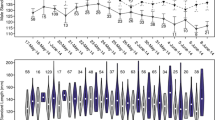Abstract
The mating system and protandrous sex change of the platycephalid fish Thysanophrys celebica were examined by collection and observation in the field and by use of aquarium experiments. Male–female pairs formed in the afternoon, and performed spawning behavior at night during the warmest season from July to early September. The pair bond was temporary, and both sexes subsequently changed partners. In pairs, the female was always larger than the male, although there were no significant size-assortative relationships between males and females in the pair. Home ranges of females and males overlapped, indicative of an absence of territoriality. Tagged individuals did not stay in the study area. These results indicate that random mating occurs for this species. Protandrous sex change of T. celebica was confirmed by field observation of a tagged individual and by aquarium experiments. Males (≤116 mm total length) changed sex at 2 years old, and females (≥97 mm) at 3–5 years old. Because males changed sex even in the presence of larger females, sex change was not socially controlled. Consequently, reversed (female-to-male) sex change did not occur in aquarium experiments with rearing females only. For this species, it is suggested that random mating favors protandrous sex change at a fixed age and/or size, not depending on social status, as the original size-advantage model has predicted.




Similar content being viewed by others
References
Aoyama T, Kitajima T, Mizue K (1963) Study of the sex reversal of inegochi, Cociella crocodila (Tilesius). Bull Seikai Reg Fish Res Lab 29:11–33
Buston P (2003) Social hierarchies: size and growth modification in clownfish. Nature 424:145–146
Charnov EL (1982) The theory of sex allocation. Princeton University Press, Princeton
Fricke H, Fricke S (1977) Monogamy and sex change by aggressive dominance in coral reef fish. Nature 266:830–832
Fujii T (1970) Hermaphroditism and sex reversal in the fishes of the Platycephalidae I. Sex reversal of Onigocia macrolepis (Bleeker). Jpn J Ichthyol 17:14–21
Fujii T (1971) Hermaphroditism and sex reversal in the fishes of the Platycephalidae II. Kumococius detrusus and Inegocia japonica. Jpn J Ichthyol 18:109–117
Fujii T (1974) Hermaphroditism and sex reversal in the fishes of the Platycephalidae III. Variation in the mode of sex reversal and speciation. Jpn J Ichthyol 21:92–100
Ghiselin MT (1969) The evolution of hermaphroditism among animals. Quart Rev Biol 44:189–208
Hattori A (2012) Determinants of body size composition in limited shelter space: why are anemonefishes protandrous? Behav Ecol 23:512–520
Imamura H (1996) Phylogeny of the family Platycephalidae and related taxa (Pisces: Scorpaeniformes). Spec Div 1:123–233
Kuwamura T, Nakashima Y (1998) New aspects of sex change among reef fishes: recent studies in Japan. Environ Biol Fish 52:125–135
Kuwamura T, Nakashima Y, Yogo Y (1994) Sex change in either direction by growth rate advantage in the monogamous coral goby, Paragobiodon echinocephalus. Behav Ecol 5:434–438
Kuwamura T, Kadota T, Suzuki S (2015) Bidirectional sex change in the magenta dottyback Pictichromis porphyrea: first evidence from the field in Pseudochromidae. Environ Biol Fish 98:201–207
Manabe H, Toyoda K, Nagamoto K, Dewa S, Sakurai M, Hagiwara K, Shinomiya A, Sunobe T (2013) Bidirectional sex change in seven species of Priolepis (Actinopterygii: Gobiidae). Bull Mar Sci 89:635–642
Munday PL, Buston PM, Warner RR (2006) Diversity and flexibility of sex-change strategies in animals. Trend Ecol Evol 21:89–95
Munday PL, Kuwamura T, Kroon FJ (2010) Bidirectional sex change in marine fishes. In: Cole KS (ed) Reproduction and sexuality in marine fishes: patterns and processes. Univ. California Press, California, pp 241–271
Nakabo T, Kai Y (2013) Platycephalidae. In: Nakabo T (ed) Fishes of Japan with pictorial keys to the species, 3rd edn. Tokai University Press, Hadano, pp 734–740
Okada YK (1966) Sex reversal in Inegocia meerdervoorti, with special reference to repetition of hermaphroditic state. Proc Jpn Acad 42:497–502
Robertson DR (1972) Social control of sex-reversal in a coral reef fish. Science 177:1007–1009
Sadovy de Mitcheson Y, Liu M (2008) Functional hermaphroditism in teleosts. Fish Fish 9:1–43
Shinomiya A, Yamada M, Sunobe T (2003) Mating system and protandrous sex change in the lizard flathead, Inegocia japonica (Platycephalidae). Ichthyol Res 50:383–386
Warner RR (1975) The adaptive significance of sequential hermaphroditism in animals. Am Nat 109:61–82
Warner RR (1988) Sex change in fishes: hypothesis, evidence and objections. Environ Biol Fish 22:81–90
Acknowledgments
We are grateful to M. Mashiko, S. Shimizu, S. Endo, and S. Tomatsu for their assistance with the field observations. This work was supported by JSPS KAKENHI grants to T.S. (nos 19570016 and 24370006) and to T.K. (nos 21570026 and 24570033) from the Japan Society for the Promotion of Science.
Author information
Authors and Affiliations
Corresponding author
About this article
Cite this article
Sunobe, T., Sakaida, S. & Kuwamura, T. Random mating and protandrous sex change of the platycephalid fish Thysanophrys celebica (Platycephalidae). J Ethol 34, 15–21 (2016). https://doi.org/10.1007/s10164-015-0439-3
Received:
Accepted:
Published:
Issue Date:
DOI: https://doi.org/10.1007/s10164-015-0439-3




